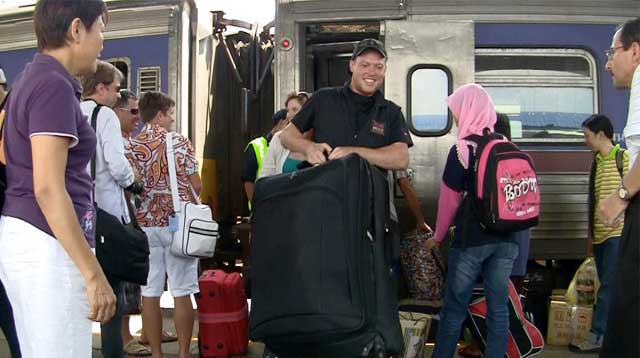A little more than seven years ago, when I was living and traveling full-time in Thailand, I had one of the best train-travel experiences of my life while traveling south out of Bangkok to the town of Surat Thani. I was sharing a second-class sleeper car with a Kiwi guy who was carrying a bottle of Mekhong whiskey, and at some point the two of us walked down to the train’s dining car and shared the whiskey with a rag-tag bunch of Thais, Brits, and Israelis. I’ve never written about the ensuing experience — but it was one of those classic nights that make travel so special: A dozen or so people from five different countries getting tipsy and telling stories and offering advice to each other as we rattled our way through the lush Asian countryside. We learned Thai phrases together and sang silly pop songs and toasted each other’s health, our voices blending in a happy yawp of international brotherhood.
Since I was covering the same route on my no-baggage transit from Thailand into Malaysia, I decided to relive that experience by buying a bottle of Mekhong whiskey in the Bangkok train station, and sharing it with new friends as the journey progressed. Unfortunately, re-creating a previous travel epiphany tends to require more than a bottle of cheap Thai whiskey — and this journey turned out to be more random than my south-bound train experience of seven years before.
Regardless of how this particular journey turned out, I consider an overnight trip on a second-class sleeper in Thailand to be one of the great world train experiences. I’ve traveled across Russia, Australia, and India by train at various points in my travel career, but (while less legendary by global reputation) Thai trains are as enjoyable as any in the world. There’s something about the tidy efficiency of a second-class sleeper, with its tasty food, comfortable berths, and cheap fares (less than US$40 for a 24-hour ride from Bangkok to Penang) that makes it a joy to ride. When the train attendant comes out in the evening and breaks the day-table into a two-tier bunk bed with full linens, it’s like watching a ritual of precision as mesmerizing and authentic to Thailand as khon dancing.
On this trip Justin and I shared seat-space with a Thai college student named Goi and a 58-year-old American traveler named Paul, but — as is the case on Thai trains — our social situation was fluid. My favorite companions on sleeper car #3 were a 60-year-old Chinese-Malaysian plantation-owner named Saw, and a 19-year-old Indian-Malaysian student named Ranjay. Since we were bound for Malaysia, I kept asking them about their homeland — but Saw was primarily interested in talking about American professional wrestling, and Ranjay liked to steer the conversation to SpongeBob SquarePants. Since I know next to nothing about the WWE and/or SpongeBob, our conversation wound up being very lengthy, and unproductive to the point of being comical (I only regret we didn’t film it).
My trump card, or so I thought, was the Mekhong whiskey — which I took to the train’s dining car around dusk. The first indication that the bottle of Mekhong might not have the social cache I’d assumed came when I offered a shot to the train’s dishwasher, and he waved me off and produced his own bottle of Hong Thong whiskey. Technically, Hong Thong isn’t really whiskey (it has a taste closer to rum) — but then Mekhong whiskey isn’t whiskey either (it’s distilled from molasses, rice, and spices, and more or less tastes like low-grade cough medicine). After the shots of Hong Thong I joined a group of jolly Thai men, none of whom were the least bit interested in the Mekhong. The more I offered it around, the more they insisted that only crazy people drink it — and by the end of the night I felt like I’d done the Thai equivalent of offering up a bottle of Thunderbird wine to commuters on the Long Island railway. The Thai fellows stuck to beer, and I was forced to drink the Mekhong myself (with a little help from Justin) while we all chatted about religion, Thai vocabulary, and the possibility of foul play in the death of Michael Jackson.
The train rolled across the Malaysian border the following morning, and I continued my second-class sleeper social routine. One of my most intriguing new acquaintances was Erin, an Australia-bound Seattle native who was carrying so much stuff that she’d lost track of how many bags she was carrying. In addition to a 60-kilo (132-pound) suitcase full of clothing and enough antiallergenic cosmetics for a one-year stint Down Under, she and I were able to identify nine separate bags (plus a loose pillow that wouldn’t fit in any of them), many of which she had acquired during a recent shopping binge in Bangkok. She claimed that she didn’t want to go to the trouble of buying anything in Australia, but I was astounded by the sheer physical effort that went with helping her to take her bags off the train.
As I helped Erin wrestle her 60-kilo monster-bag out of the baggage compartment and onto the platform at Butterworth (near the island of Penang in Malaysia), I realized how long it had been since I’d even thought of the psychic and physical hassle that comes with carrying luggage.
Suddenly — in that moment — traveling with next-to-nothing felt like an indulgent luxury.

